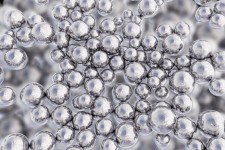 Nanoparticles via Shutterstock
Nanoparticles via Shutterstock
We have all been there, waiting outside the velvet rope peering in – knowing that what keeps us from having a great night are the big, mean bouncers standing guard. This time, however, we’ve come prepared. We are wearing the outfit – the one that not even the meanest bouncer is immune to.
This is a rather apt metaphor for nanoparticles —microscopic particles that have multiple applications — especially for cancer drug delivery. Published in the journal Nano Letters, scientists at Drexel University have been able to figure out a way to “dress” these infinitesimal vehicles in such a way to “get them past the tumor’s biological bouncers,” and to the tumor’s inner sanctum.
It has been a challenging feat to design nanoparticles that not only transport chemotherapy drugs to the cancer site, but then enable the diffusion of these particles within solid tumors. Part of the tumor’s outer environment, the extracellular matrix, provides a barrier between the tumor and the drug. To address this, scientists created an enzyme, hyaluronidase (recombinant human hyaluronidase), that they attached to nanoparticles which would enable them to break down the hyaluronic acid component of the tumor’s extracellular matrix. Hyaluronic acid reduces the therapeutic diffusion of the nanoparticles within the tumor.
By modifying the surface of the nanoparticle with polyethylene glycol (PEG) to serve as an anchor for the conjugation of hyaluronidase, the group was able to prevent the degradation of this enzyme in the body. In mouse models the result was the quadrupling and uniform distribution of these modified nanoparticles within breast tumors. A very low dose of the chemotherapy medication, doxorubicin, encapsulated within the nanoparticles had efficiently inhibited aggressive tumor growth.
This is especially important, since doxorubicin is a rather nasty chemo drug, which is reflected by its side effects. It has a high emetogenic risk, as well as significant cardiotoxicity, which limits the lifetime dose. Any technology that can localize the concentration of the drug will provide a huge benefit to the patient.
“What we’ve reported here is a strategy to overcome biological barriers that plague delivery of medication, such as non-vehicle clearance in the bloodstream by the host immune system, and ineffective diffusion in the extracellular matrix of tumor cells,” according to lead author Hao Cheng, PhD, an assistant professor with an appointment in Drexel’s College of Engineering, and affiliated with the School of Biomedical Engineering, Science and Health Systems. “It’s a unique strategy that involves the decoration of nanovehicles with enzymes known to break down hyaluronic acid, which is a main barrier in the extracellular space, and the addition of an extra layer of polyethylene glycol to partially cover the enzymes.”
The elegance of this approach has been a result of many attempts at creating a vehicle with the right amount of cargo, so that it would not be weighed down with added bulk. Drexel researchers realized that they could create nanoparticles with the proper enzymes attached to degrade the extracellular matrices of tumors. However, once in the body these particles would either end up cleared by the bloodstream or the enzymes would become inert en route to the tumor.
“The novelty of our design is that we partially embedded the hyaluronidase enzymes in a second polyethylene glycol layer to form the outer shell of the nanoparticle,” stated Dr. Cheng. “This design dramatically reduces the enzyme’s effect on slowing the particle’s circulation and allows the enzymes to maintain their function after the particle diffuses into the tumor.”
The advantages of using nanoparticles as a drug delivery system include:
- the facile manipulation of the size and surface characteristics of the nanoparticles, which can be used for both active and passive drug targeting
- nanoparticles can be designed to control and sustain drug release during transport, as well as determine the location of release
- alteration of distribution and clearance of the drug means increased drug efficacy at reduced doses, and a reduction in side effects
- multiple routes of administration (oral, nasal, injection, intra-ocular)
Hopefully, these results will provide a new weapon for effective and efficient drug delivery and distribution. This would go a long way to providing many cancer patients with a successful response to chemotherapy with markedly reduced adverse events.



